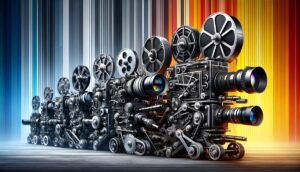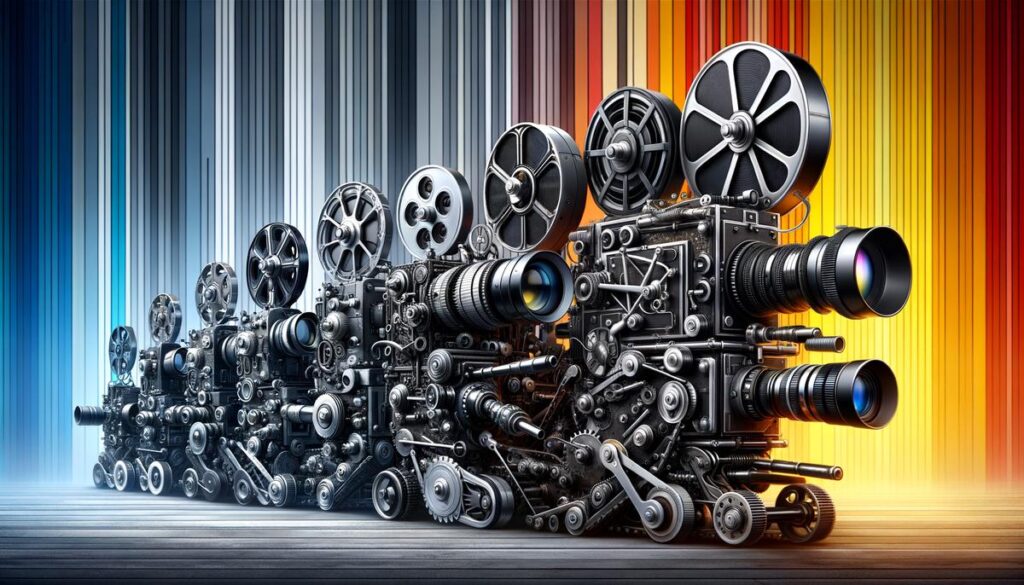The landscape of Hollywood has undergone significant transformations, driven by the relentless march of technology and changing consumer behaviors. As we journey through the various facets of this evolution, from digital cinematography to the rise of streaming platforms, and from the wonders of 3D and visual effects to the challenges posed by digital piracy, a picture emerges. This narrative paints a vivid portrayal of an industry at the crossroads of tradition and innovation, grappling with both the opportunities and obstacles presented by the digital age.
Digital Cinematography Evolution
Digital cinematography transformed Hollywood, reshaping the film industry in unprecedented ways. This transition armed directors and cinematographers with lighter, more versatile cameras, enabling shots once deemed impossible. Truckloads of film reels became obsolete as digital storage stepped in, reducing production costs and making shoots more forgiving. Take after take could be done without worrying about film costs, and footage could be immediately reviewed on set, boosting efficiency.
Digital editing software brought unmatched precision, allowing editors to splice, dice, and get creative with special effects in ways unimaginable in the film era. Digital also unlocked new realms of creativity for filmmakers to play with visual effects, from otherworldly creatures to fantastical landscapes. Movies like "Avatar" and "Gravity" showcased visually stunning and technically groundbreaking worlds.
However, the transition had its challenges. The sheer data volume of digital shoots brought storage wars, data management headaches, and questions about the 'look' digital footage brought to the big screen. Purists argued that nothing could replicate the aesthetic of traditional film.1 Behind the scenes, the industry grappled with learning new software, changing workflows, and initial resistance.
As filmmakers became adept at wielding these new tools, resistance turned to acceptance and anticipation for what could come next. Digital cinematography revolutionized storytelling, with tools allowing for capturing and creating visuals limited only by one's imagination. Each frame became a canvas for innovation, each special effect an invitation to venture into the unknown.
Notable films marked this transition, etching their names into cinematic history for their storytelling and the marriage between creativity and technology powered by digital cinematography. They stand as beacons of the revolution that reshaped Hollywood, turning traditional filmmaking on its head and ushering in a new era of cinematic expression.
Photo by thisisengineering on Unsplash
Rise of Streaming Platforms
Streaming services have flipped the script on Hollywood's traditional distribution model. Netflix, Amazon Prime, and Hulu have marched into the fray, changing how we consume films and series.
These streaming giants democratized access to movies. Audiences no longer wait months to catch the latest flick on DVD or reruns on cable. With a few clicks, a world of cinema unfolds in their living rooms or during a commute. This convenience captivated audiences and shifted where they spend their dollars, impacting box office sales as more viewers trade cinema seats for their couches.
Hollywood studios are reevaluating their formulas for profitability. The metrics of success now include licensing deals with streaming platforms, a critical revenue stream demanding a balancing act. Studios weigh the immediate payday of selling streaming rights against potential long-term earnings from traditional routes.
The shake-up sparked an era of unprecedented original content production. Streaming services, with their user data, finely tune offerings to match viewer preferences, leading to a surge in diverse and niche content.2 Traditional studios launched their own streaming platforms to capture a slice of this lucrative pie, intensifying the battle for audiences and driving a frenetic pace of content production.
Studios grapple with diminished control over their releases. The strategic release windows that maximized attention and profits have blurred, making blockbuster seasons less predictable. Audience habits are shifting, with the culture of binge-watching ushering in a new era of consumption where patience for weekly releases wears thin.
Streaming platforms have disrupted Hollywood's once ironclad distribution model. Studios are racing to adapt to a landscape where digital reigns supreme, redefining success in an industry renowned for its spectacle and storytelling. As screens multiply and media consumption morphs, the script for getting movies to audiences has undergone a rewrite, with streaming services holding the pen.
3D and Visual Effects Innovations
3D technology and visual effects (VFX) have taken storytelling and cinematic experiences to a whole new level, rewriting the playbook on what's possible in Hollywood productions.
Modern 3D technology is a complete immersion strategy, inviting audiences to step into the movie. Movies like "Avatar" and "Life of Pi" didn't just show another world—they wrapped you in it, thanks to 3D. This tech, partnered with VFX, allows filmmakers to dream bigger, turning storyboard fantasies into realistic settings you could almost reach out and touch.
"Inception's" bending cities or "Gravity's" breathtaking space walks wouldn't have been quite so jaw-dropping without advancements in VFX. Today's technology lets creators mold the universe to their vision with fewer boundaries. Effects can be as subtle as digitally aged characters or impossible camera movements, adding layers to storytelling without distracting from the plot.
These marvels require a dance of choreographed pixels that only the most skilled VFX artists can pull off. The challenge is making sure these outstanding visuals bolster the story rather than overshadowing it. As technology becomes more sophisticated, integrating these elements seamlessly becomes both more possible and more demanding.
High-quality VFX and 3D technology come at a cost, setting a high bar for filmmakers who dare to dream. It pushes producers to find the sweet spot between mind-blowing visuals and a budget that won't burst at the seams. These technologies have initiated debate within the industry about the perceived pressure to create blockbusters that are spectacle over substance.
Audience expectations have skyrocketed. This demand for visually groundbreaking cinematography has changed how stories are told, pushing filmmakers to weave these elements into the narrative's core.
Actors often perform in vastly empty studios, reacting to characters and environments they can't see, relying on their imagination more than ever before.3 It's a testament to their skill and the directors' guidance that these performances feel so real in the finished product.
3D technology and VFX have expanded Hollywood's universe. They've brought us closer to distant galaxies, made us ponder alternate realities, and turned the fantastical into the nearly tangible. Yet, amidst the digital waves, the age-old craft of storytelling still sails strong.
Photo by natedefiesta on Unsplash
AI and Machine Learning in Filmmaking
AI and machine learning are taking roles beyond technical tweaks in Hollywood. They're playing director's assistants, helping scout talent through casting AI, which analyzes actors' previous performances to predict on-screen chemistry and fit for roles. These algorithms can spot potential blockbuster scripts from a virtual mountain of options, sifting through plots and dialogue to identify patterns that align with box-office hits.
Marketing departments rely on AI-driven data analysis to predict audience preferences, ensuring trailers and promotional materials hit the emotional mark. These insights help studios decide on release schedules and fine-tune marketing campaigns for maximum impact.
In post-production, machine learning tools analyze countless hours of footage, offering suggestions for cuts or scene rearrangements that might better convey the story or heighten tension—filmmakers can explore alternative narratives without getting lost in footage.
The ethical questions around this technology loom large. The use of deepfakes and digital recreation of actors begs the conversation about consent and copyright. There's a tightrope walk between enhancing storytelling and venturing into manipulation that the industry is still figuring out.
AI-driven decisions raise discussions around creativity—where does the algorithm end and human imagination begin? These complex synthesizations of tech and tale reveal Hollywood's storyline is undergoing its most thrilling plot twist yet, embracing AI and machine learning in creating cinematic magic that pushes the envelope, all while navigating a galaxy of ethical considerations.
Impact of Digital Piracy
Digital piracy has hit Hollywood like a storm, with studios standing to lose billions of dollars annually.4 The film industry has evolved beyond traditional security measures to grapple with this pervasive issue. Pirate websites offering free movie downloads are like digital hydra heads; shut one down, and two spring up in its place. Hollywood's revenue takes direct hits from these activities, but the response has been swift and multifaceted, encompassing legal, technological, and strategic adjustments.
Hollywood studios have ramped up their game by spearheading lawsuits against major pirate sites and individuals sharing copyrighted material illegally. They've also lobbied for stricter copyright laws around the world. Their efforts have scored some victories, showing piracy rings and casual sharers alike that the studios mean business.
Hollywood has looked to innovative digital watermarking and encryption technologies for content protection. These methods aim to trace the origin of leaked content and block unauthorized sharing. Industry giants have even experimented with releasing movies online simultaneously worldwide to reduce the temptation of piracy by making content readily accessible.
The advent of affordable, user-friendly streaming services presented as a direct counter to piracy. Companies like Netflix have changed how people consume media by offering vast libraries of movies and shows at reasonable prices. It's more convenience and variety at one's fingertips, a value proposition that piracy sites struggle to match.
Studios have embraced the idea of creating content that's too good to pirate. Films and series with high production values, incorporating stunning visual effects and immersive storytelling, are drawing audiences back to the paid fold. The success strategy lies in offering a viewing experience that pirated copies can't replicate—be it through superior sound and picture quality or exclusive behind-the-scenes content.
Hollywood's battle against digital piracy is ongoing, with no perfect solution in sight. It's a war fought across multiple fronts: in courthouses, through internet pipelines, inside creative studios, and anywhere else innovation might lead. The enemy is elusive and constantly evolving, but so are the guardians of Hollywood's cinematic treasures. While losses due to piracy remain hefty, the convolutions of copyright battles, technological advancements, and innovative approaches to content distribution suggest studios are far from waving the white flag. The narrative of digital piracy affecting Hollywood is an ongoing saga marked by resilience, adaptability, and the relentless pursuit of protection for artistic expression.
Photo by jeremybishop on Unsplash
In conclusion, amidst the myriad changes and advancements that have reshaped Hollywood, the essence of storytelling remains paramount. The ability to weave tales that captivate, inspire, and move audiences stands as the industry’s enduring core. As we reflect on the journey through digital landscapes, technological marvels, and shifts in viewer engagement, it becomes clear that the heart of Hollywood’s narrative lies in its unwavering commitment to storytelling. This central theme underscores the ongoing evolution of cinema, reminding us that at its core, filmmaking is about connecting with audiences through the power of story.
- Prince S. Digital video and HD: Algorithms and Interfaces. Morgan Kaufmann; 2012.
- Jenner M. Netflix and the Re-invention of Television. Springer; 2018.
- North D, Rehak B, Duffy MS. Special Effects: New Histories, Theories, Contexts. Bloomsbury Publishing; 2020.
- Waldfogel J. Digital piracy: empirics. In: Towse R, Handke C, eds. Handbook on the Digital Creative Economy. Edward Elgar Publishing; 2013:512-527.
Revolutionize your content with Writio, the AI content writer. This article was crafted by Writio.


